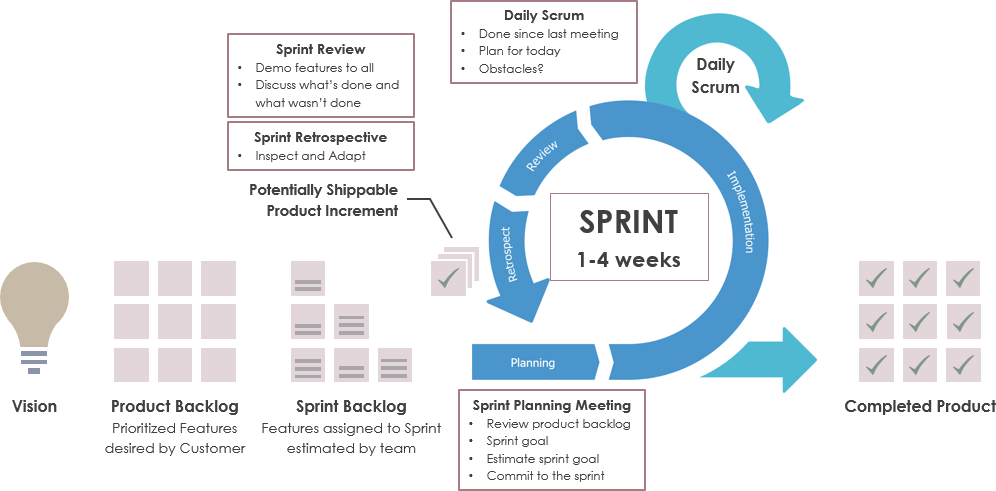Interconnected Concepts in Agile Development: From Product Backlog to Deliverables
Introduction
In the dynamic realm of Agile software development, a web of interconnected concepts ensures the seamless flow of work, the attainment of high-quality outcomes, and the meeting of project objectives. At the heart of this ecosystem are the Product Backlog, Sprint Planning, Definition of Ready, Sprint, Definition of Done, and Deliverables. Understanding how these elements relate to each other is essential for Agile teams striving to deliver value with precision and efficiency.
This article explores these fundamental Agile concepts and their intricate connections, shedding light on how they collectively shape the Agile development landscape. From the initial envisioning of product features in the Product Backlog to the final delivery of polished Deliverables, each component plays a crucial role in the Agile development journey. Let’s navigate this Agile web to grasp the essence of these concepts and their synergistic relationships.

From Product Backlog to Deliverables
In Agile software development, several concepts are interconnected to ensure a streamlined and efficient development process. Let’s explore how these concepts relate to one another:
-
Product Backlog:
- Relation to Sprint Planning: The product backlog is the starting point for sprint planning. It’s a prioritized list of features, user stories, and tasks that need to be addressed in the project. During sprint planning, the team selects items from the product backlog to include in the upcoming sprint.
-
Sprint Planning:
- Relation to Product Backlog: Sprint planning involves choosing items from the product backlog to include in the sprint backlog for the upcoming sprint. It’s a collaborative effort between the product owner, the development team, and the Scrum Master (in Scrum methodology).
- Definition of Ready: As part of sprint planning, the team defines what it means for a product backlog item to be “ready” for inclusion in the sprint backlog. This includes specifying clear acceptance criteria and ensuring that all necessary information is available.
-
Definition of Ready (DoR):
- Relation to Sprint Planning: DoR criteria are crucial during sprint planning to determine which product backlog items are ready to be included in the sprint. If an item doesn’t meet the DoR, it’s refined or postponed until it meets the criteria.
-
Sprint:
- Relation to Sprint Planning: A sprint is a time-boxed iteration during which the development team works on a set of product backlog items selected during sprint planning. The sprint has a fixed duration, typically 2 to 4 weeks.
- Relation to Definition of Done: During sprint planning, the team should also consider what it means for a product backlog item to be “done” within the sprint, i.e., the Definition of Done (DoD) criteria. This helps ensure that the work is completed to the necessary quality standards by the end of the sprint.
-
Definition of Done (DoD):
- Relation to Sprint: The DoD defines the quality and completeness criteria that a product backlog item must meet to be considered finished. It’s essential during the sprint to ensure that work is not only completed but also meets the agreed-upon standards.
- Relation to Deliverables: The DoD often forms the basis for defining what constitutes the deliverables for the sprint. It includes criteria such as code review, testing, documentation, and integration, ensuring that the deliverables are not just partial solutions but fully functional and ready for deployment.
-
Deliverables:
- Relation to Sprint: The deliverables for a sprint are the tangible results or outcomes of the sprint’s work. They are typically product features, user stories, or tasks that have been completed according to the Definition of Done and are ready for review and potential release.
- Relation to Product Backlog: Once the sprint is completed, the deliverables are often presented to stakeholders, reviewed, and potentially added to the product backlog if they need further refinement or are not yet ready for release.
These Agile concepts are interconnected and work together to ensure that work is selected, planned, executed, and delivered efficiently and with high quality. The product backlog guides what needs to be done, sprint planning selects items for the sprint, the Definition of Ready and Definition of Done set quality standards, and deliverables are the tangible outcomes of the sprint’s work. This interconnectedness promotes transparency, collaboration, and adaptability in Agile development processes.
Summary
In the realm of Agile software development, success hinges on a web of interconnected concepts that guide and govern the development process. At the outset, the Product Backlog serves as the reservoir of project requirements and aspirations. During Sprint Planning, this backlog is transformed into actionable tasks for the upcoming Sprint, with the team ensuring that the items meet the Definition of Ready (DoR) criteria.
The Sprint, a fixed-duration development cycle, sees these tasks coming to life as the team diligently works towards fulfilling the Sprint’s goals. To maintain quality and completeness, the team follows the Definition of Done (DoD) criteria, which define the finishing standards. At the end of the Sprint, the tangible outcomes, or Deliverables, emerge as the fruits of the team’s labor.
This intricate choreography of Agile concepts ensures transparency, collaboration, and adaptability throughout the development process, ultimately leading to the successful delivery of valuable software solutions. By understanding the interplay between these elements, Agile teams can navigate their projects with precision and efficiency, delivering results that meet both stakeholder expectations and industry standards.

